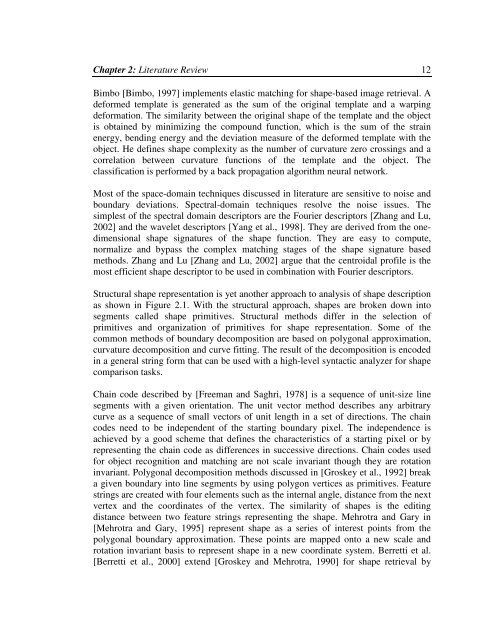To the Graduate Council: I am submitting herewith a thesis written by ...
To the Graduate Council: I am submitting herewith a thesis written by ...
To the Graduate Council: I am submitting herewith a thesis written by ...
Create successful ePaper yourself
Turn your PDF publications into a flip-book with our unique Google optimized e-Paper software.
Chapter 2: Literature Review 12Bimbo [Bimbo, 1997] implements elastic matching for shape-based image retrieval. Adeformed template is generated as <strong>the</strong> sum of <strong>the</strong> original template and a warpingdeformation. The similarity between <strong>the</strong> original shape of <strong>the</strong> template and <strong>the</strong> objectis obtained <strong>by</strong> minimizing <strong>the</strong> compound function, which is <strong>the</strong> sum of <strong>the</strong> strainenergy, bending energy and <strong>the</strong> deviation measure of <strong>the</strong> deformed template with <strong>the</strong>object. He defines shape complexity as <strong>the</strong> number of curvature zero crossings and acorrelation between curvature functions of <strong>the</strong> template and <strong>the</strong> object. Theclassification is performed <strong>by</strong> a back propagation algorithm neural network.Most of <strong>the</strong> space-domain techniques discussed in literature are sensitive to noise andboundary deviations. Spectral-domain techniques resolve <strong>the</strong> noise issues. Thesimplest of <strong>the</strong> spectral domain descriptors are <strong>the</strong> Fourier descriptors [Zhang and Lu,2002] and <strong>the</strong> wavelet descriptors [Yang et al., 1998]. They are derived from <strong>the</strong> onedimensionalshape signatures of <strong>the</strong> shape function. They are easy to compute,normalize and <strong>by</strong>pass <strong>the</strong> complex matching stages of <strong>the</strong> shape signature basedmethods. Zhang and Lu [Zhang and Lu, 2002] argue that <strong>the</strong> centroidal profile is <strong>the</strong>most efficient shape descriptor to be used in combination with Fourier descriptors.Structural shape representation is yet ano<strong>the</strong>r approach to analysis of shape descriptionas shown in Figure 2.1. With <strong>the</strong> structural approach, shapes are broken down intosegments called shape primitives. Structural methods differ in <strong>the</strong> selection ofprimitives and organization of primitives for shape representation. Some of <strong>the</strong>common methods of boundary decomposition are based on polygonal approximation,curvature decomposition and curve fitting. The result of <strong>the</strong> decomposition is encodedin a general string form that can be used with a high-level syntactic analyzer for shapecomparison tasks.Chain code described <strong>by</strong> [Freeman and Saghri, 1978] is a sequence of unit-size linesegments with a given orientation. The unit vector method describes any arbitrarycurve as a sequence of small vectors of unit length in a set of directions. The chaincodes need to be independent of <strong>the</strong> starting boundary pixel. The independence isachieved <strong>by</strong> a good scheme that defines <strong>the</strong> characteristics of a starting pixel or <strong>by</strong>representing <strong>the</strong> chain code as differences in successive directions. Chain codes usedfor object recognition and matching are not scale invariant though <strong>the</strong>y are rotationinvariant. Polygonal decomposition methods discussed in [Groskey et al., 1992] breaka given boundary into line segments <strong>by</strong> using polygon vertices as primitives. Featurestrings are created with four elements such as <strong>the</strong> internal angle, distance from <strong>the</strong> nextvertex and <strong>the</strong> coordinates of <strong>the</strong> vertex. The similarity of shapes is <strong>the</strong> editingdistance between two feature strings representing <strong>the</strong> shape. Mehrotra and Gary in[Mehrotra and Gary, 1995] represent shape as a series of interest points from <strong>the</strong>polygonal boundary approximation. These points are mapped onto a new scale androtation invariant basis to represent shape in a new coordinate system. Berretti et al.[Berretti et al., 2000] extend [Groskey and Mehrotra, 1990] for shape retrieval <strong>by</strong>
















